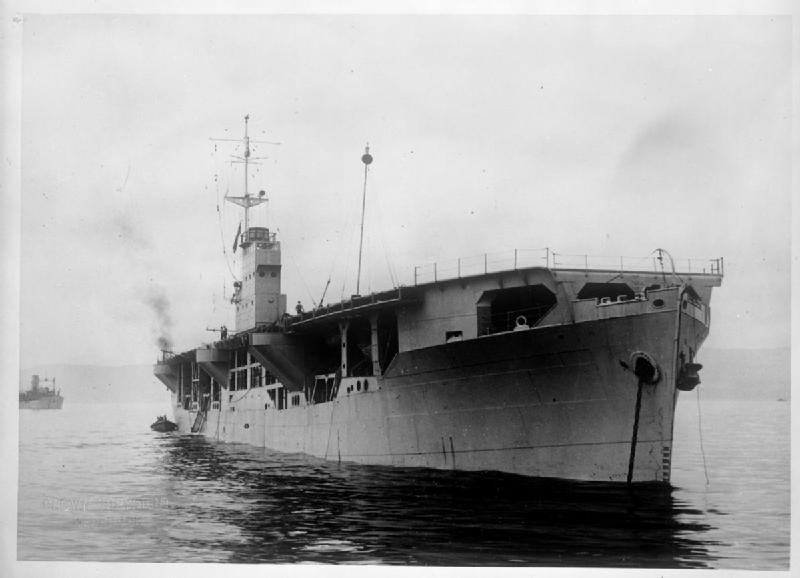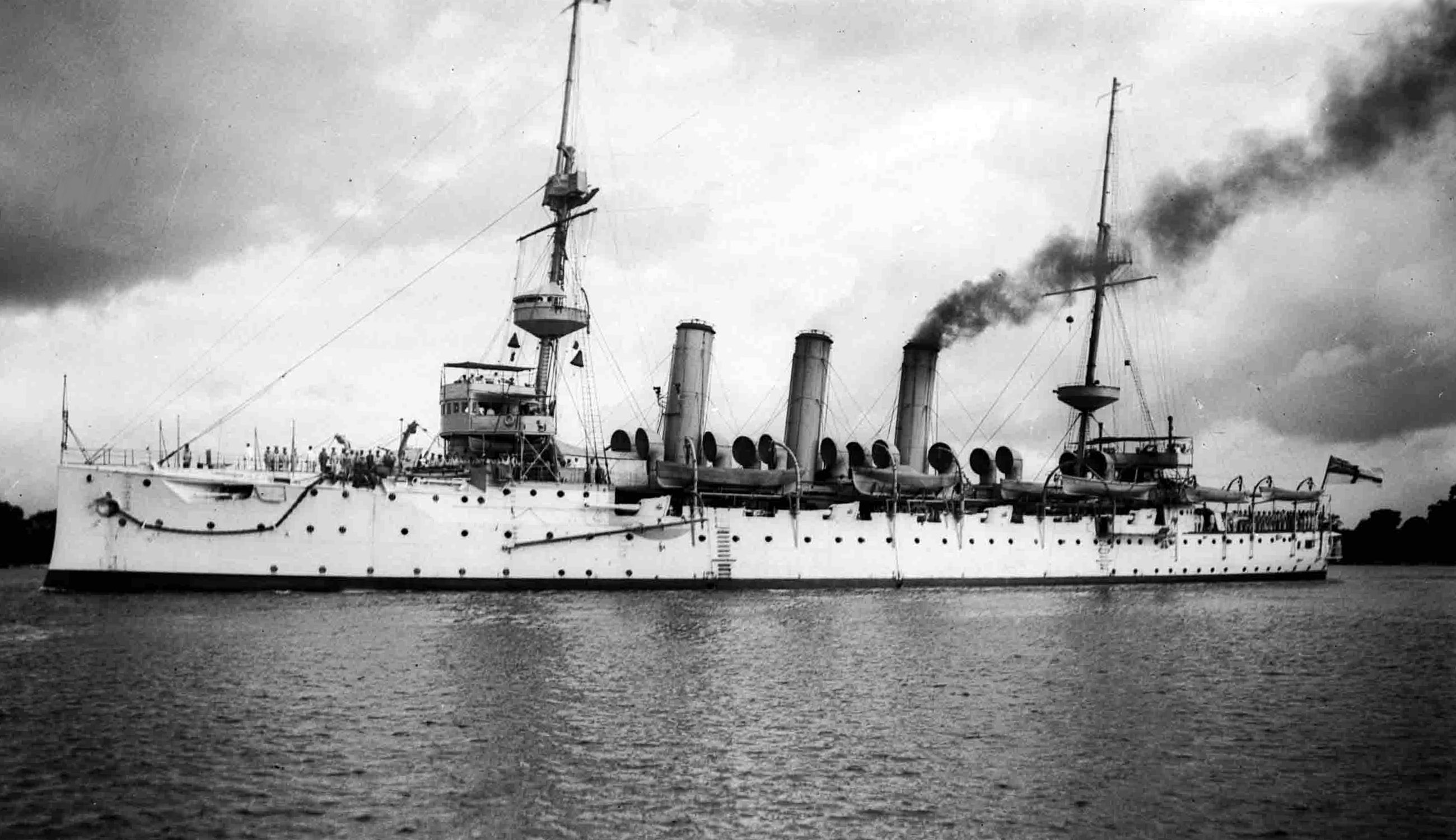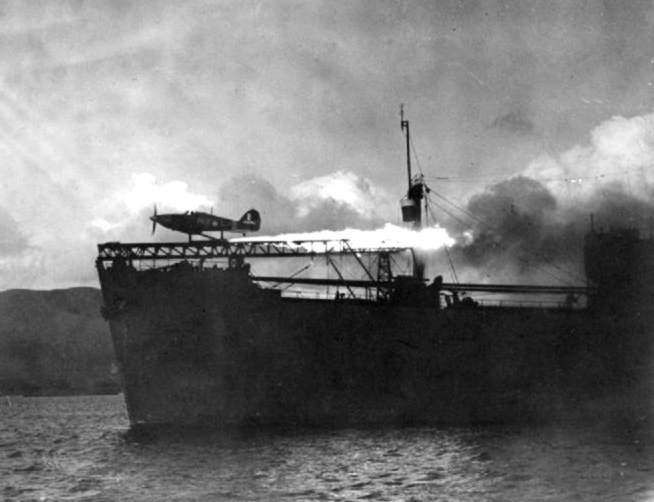|
Fighter Catapult Ship
Fighter catapult ships also known as Catapult Armed Ships were an attempt by the Royal Navy to provide air cover at sea. Five ships were acquired and commissioned as Naval vessels early in the Second World War, and these were used to accompany convoys. The concept was extended to merchant ships which were also equipped with rocket assisted launch systems and known as Catapult Aircraft Merchantmen ( CAM ships). Both classes could launch a disposable fighter (usually a Hawker Hurricane) to fight off a threat, with the pilot expected to be rescued after either ditching the aircraft or bailing out close to the launching ship. The ships There were five fighter catapult ships, collectively known as the ''Pegasus'' class. Two, ''Patia'' and ''Springbank'', were lost during the war. They were each equipped with a single Fairey Fulmar or "Hurricat" (an adapted Hawker Hurricane Mk.1A). See also * List of ships of the Second World War * List of aircraft carriers of the Second World War * ... [...More Info...] [...Related Items...] OR: [Wikipedia] [Google] [Baidu] |
Royal Navy
The Royal Navy (RN) is the United Kingdom's naval warfare force. Although warships were used by English and Scottish kings from the early medieval period, the first major maritime engagements were fought in the Hundred Years' War against France. The modern Royal Navy traces its origins to the early 16th century; the oldest of the UK's armed services, it is consequently known as the Senior Service. From the middle decades of the 17th century, and through the 18th century, the Royal Navy vied with the Dutch Navy and later with the French Navy for maritime supremacy. From the mid 18th century, it was the world's most powerful navy until the Second World War. The Royal Navy played a key part in establishing and defending the British Empire, and four Imperial fortress colonies and a string of imperial bases and coaling stations secured the Royal Navy's ability to assert naval superiority globally. Owing to this historical prominence, it is common, even among non-Britons, to ref ... [...More Info...] [...Related Items...] OR: [Wikipedia] [Google] [Baidu] |
HMS Ark Royal (1914)
HMS ''Ark Royal'' was the first ship designed and built as a seaplane carrier. She was purchased by the Royal Navy in 1914 shortly after her keel had been laid and the ship was only in frames; this allowed the ship's design to be modified almost totally to accommodate seaplanes. During the First World War, ''Ark Royal'' participated in the Gallipoli Campaign in early 1915, with her aircraft conducting aerial reconnaissance and observation missions. Her aircraft later supported British troops on the Macedonian Front in 1916, before she returned to the Dardanelles to act as a depot ship for all the seaplanes operating in the area. In January 1918, several of her aircraft unsuccessfully attacked the German battlecruiser when she sortied from the Dardanelles to attack Allied ships in the area. The ship left the area later in the year to support seaplanes conducting anti-submarine patrols over the southern Aegean Sea. After the end of the war, ''Ark Royal'' mostly served as an ... [...More Info...] [...Related Items...] OR: [Wikipedia] [Google] [Baidu] |
Ship Types
A ship is a large watercraft that travels the world's oceans and other sufficiently deep waterways, carrying cargo or passengers, or in support of specialized missions, such as defense, research, and fishing. Ships are generally distinguished from boats, based on size, shape, load capacity, and purpose. Ships have supported exploration, trade, warfare, migration, colonization, and science. After the 15th century, new crops that had come from and to the Americas via the European seafarers significantly contributed to world population growth. Ship transport is responsible for the largest portion of world commerce. The word ''ship'' has meant, depending on the era and the context, either just a large vessel or specifically a ship-rigged sailing ship with three or more masts, each of which is square-rigged. As of 2016, there were more than 49,000 merchant ships, totaling almost 1.8 billion dead weight tons. Of these 28% were oil tankers, 43% were bulk carriers, and 13% were con ... [...More Info...] [...Related Items...] OR: [Wikipedia] [Google] [Baidu] |
Aircraft Cruiser
The aircraft cruiser (also known as aviation cruiser or cruiser-carrier) is a warship that combines the features of the aircraft carrier and a surface warship such as a cruiser or battleship. Early types The first aircraft cruiser was originally a 1930s experimental concept of creating an all-around warship. The early aircraft cruisers were usually armed with relatively heavy artillery, mines and a number of aircraft fitted with floats (making the ship a kind of seaplane tender/fighter catapult ship). The early aircraft cruiser turned out to be an unsuccessful design. The rapid development of naval aircraft in the 1930s quickly rendered the vessels obsolete, and they were rebuilt e.g. as anti-aircraft cruisers. A United States design for a flight deck cruiser from 1930,Friedman 1983, p.179. was described as "a light cruiser forwards ndone half of a aft". Although not built, similar ships were created during and after World War II as reconstructions and later from the keel up. ... [...More Info...] [...Related Items...] OR: [Wikipedia] [Google] [Baidu] |
Merchant Aircraft Carrier
A merchant aircraft carrier (also known as a MAC ship, the Admiralty's official 'short name') was a limited-purpose aircraft carrier operated under British and Dutch civilian registry during World War II. MAC ships were adapted by adding a flight deck to a bulk grain ship or oil tanker enabling it to operate anti-submarine aircraft in support of Allied convoys during the Battle of the Atlantic. Despite their quasi-military function, MAC ships retained their mercantile status, continued to carry cargo and operated under civilian command. MAC ships entered service from May 1943 when they began to supplement and supplant escort carriers, and remained operational until the end of the war in Europe. Development In 1940, Captain M. S. Slattery RN, Director of Air Material at the Admiralty, proposed a scheme for converting merchant ships into aircraft carriers as a follow-up to the CAM ship project. Slattery proposed fitting a flight deck equipped with two arrester wires and a safe ... [...More Info...] [...Related Items...] OR: [Wikipedia] [Google] [Baidu] |
List Of Aircraft Carriers Of The Second World War
This is a list of aircraft carriers of the Second World War. Aircraft carriers serve as a seagoing airbases, equipped with a flight deck and facilities for carrying, arming, deploying and recovering aircraft. Typically, they are the capital ships of a fleet, as they project air power worldwide without depending on local bases for operational support. Aircraft carriers are expensive and are considered critical assets. By the Second World War aircraft carriers had evolved from converted cruisers, to purpose built vessels of many classes and roles. Fleet carriers were the largest type, operating with the main fleet to provided offensive capability. Light aircraft carriers were fast enough to operate with the fleet but smaller and with fewer aircraft. Escort carriers were smaller and slower, with low numbers of aircraft, and provided defense for convoys. Most of the latter were built from mercantile hulls or, in the case of merchant aircraft carriers, were bulk cargo ships with a f ... [...More Info...] [...Related Items...] OR: [Wikipedia] [Google] [Baidu] |
List Of Ships Of The Second World War
This list of ships of the Second World War contains major military vessels of the war, arranged alphabetically and by type. The list includes armed vessels that served during the war and in the immediate aftermath, inclusive of localized ongoing combat operations, garrison surrenders, post-surrender occupation, colony re-occupation, troop and prisoner repatriation, to the end of 1945. For smaller vessels, see also list of World War II ships of less than 1000 tons. Some uncompleted Axis ships are included, out of historic interest. Ships are designated to the country under which they operated for the longest period of the Second World War, regardless of where they were built or previous service history. Naval warfare changed dramatically during the war, with the ascent of the aircraft carrier, and the impact of increasingly capable submarines. Destroyers saw dramatic improvements, as the set a new standard not only for Japanese vessels, but for navies around the world, and are con ... [...More Info...] [...Related Items...] OR: [Wikipedia] [Google] [Baidu] |
HMS Springbank
HMS ''Springbank'' was a Royal Navy fighter catapult ship of the Second World War. Originally a cargo ship built in 1926 for Bank Line it was acquired by the Admiralty at the start of the war and converted to an "auxiliary anti-aircraft cruiser" by the addition of four twin gun turrets and two quadruple 2 pdr (40 mm) "pom-pom"s. In March 1941 a catapult for a single Fairey Fulmar naval fighter (from 804 Naval Air Squadron) was fitted midships as a means to give further protection for convoys from enemy aircraft. ''Springbank'' was part of the escort for Convoy HG 73 from Gibraltar to Liverpool. ''Springbank''s Fulmar was launched to drive off a German Focke-Wulf Fw 200 The Focke-Wulf Fw 200 ''Condor'', also known as ''Kurier'' to the Allies (English language, English: Courier), was a Nazi Germany, German all-metal four-engined monoplane originally developed by Focke-Wulf as a long-range airliner. A Japanese req ... reconnaissance aircraft; the Fulmar landing at Gibralta ... [...More Info...] [...Related Items...] OR: [Wikipedia] [Google] [Baidu] |
Seaplane Carrier
A seaplane tender is a boat or ship that supports the operation of seaplanes. Some of these vessels, known as seaplane carriers, could not only carry seaplanes but also provided all the facilities needed for their operation; these ships are regarded by some as the first aircraft carriers and appeared just before the First World War. Terminology In maritime parlance a tender is a vessel that is used to support the operation of other vessels. In British usage, the term tender was used for small craft, with the term depot ship being used for large seagoing vessels. Flying boats and float planes even when based at home in ports and harbour had a need for small support vessels to operate.p British tenders were small craft of launch to pinnace size. These were used to ferry crews, stores and supplies between shore and the aircraft, to maintain the buoys used to mark out "taxiways" and "runways" and to keep these clear of debris to prevent foreign object damage, and in the case of ... [...More Info...] [...Related Items...] OR: [Wikipedia] [Google] [Baidu] |
804 Naval Air Squadron
804 Naval Air Squadron (804 NAS) was a Naval Air Squadron of the Royal Navy, formed in November 1939 from part of 769 NAS Sea Gladiators which had been detached to RNAS Hatston. The squadron was merged into 800 NAS in June 1944 and subsequently reformed in September. World War II During World War II, she was equipped with various aircraft types in differing roles. When formed at Hatston, 804 used Gloster Sea Gladiators in defence of the naval base at Scapa Flow, but was transferred in April 1940 to to provide air cover for the ferrying of 269 Squadron RAF's Gladiators to Norway after the German invasion. This was a brief assignment and in early May the squadron was transferred to at Campbeltown, thus missing ''Glorious''s sinking. Between May and September 1940 804 squadron returned to Hatston, and was subsequently recognised as one of the two FAA squadrons that operated with RAF Fighter Command in the Battle of Britain. In October 1940 804 Squadron was re-equipped wit ... [...More Info...] [...Related Items...] OR: [Wikipedia] [Google] [Baidu] |
World War II
World War II or the Second World War, often abbreviated as WWII or WW2, was a world war that lasted from 1939 to 1945. It involved the vast majority of the world's countries—including all of the great powers—forming two opposing military alliances: the Allies and the Axis powers. World War II was a total war that directly involved more than 100 million personnel from more than 30 countries. The major participants in the war threw their entire economic, industrial, and scientific capabilities behind the war effort, blurring the distinction between civilian and military resources. Aircraft played a major role in the conflict, enabling the strategic bombing of population centres and deploying the only two nuclear weapons ever used in war. World War II was by far the deadliest conflict in human history; it resulted in 70 to 85 million fatalities, mostly among civilians. Tens of millions died due to genocides (including the Holocaust), starvation, ma ... [...More Info...] [...Related Items...] OR: [Wikipedia] [Google] [Baidu] |
Robert W H Everett
Robert William Hanmer Everett (29 May 1901 – 26 January 1942) was a British jockey and a Royal Navy Volunteer Reserve pilot during the Second World War. In 1929, he won the Grand National on Gregalach. In 1941, as a Fleet Air Arm pilot, he achieved the first "kill" by a rocket-launched fighter, shooting down a long-range Focke-Wulf Fw 200 Condor over the Atlantic. For this hazardous success, he was awarded the Distinguished Service Order (DSO). Knowledge of Everett's life is fragmentary, with just a few notable events. Early life Everett was born to on 29 May 1901 in Tenterfield, New South Wales, Australia. His parents were Lt. Colonel William Frank Everett and Charlotte Everett of Chelsea. In 1915 he attended the Royal Naval College, Osborne, then served for two years as a Midshipman in the Royal Navy during World War 1. After the war, he working as a farmer in South Africa, before moving to the United Kingdom in 1927 to become a National Hunt jockey. In 1929, he rode "Greg ... [...More Info...] [...Related Items...] OR: [Wikipedia] [Google] [Baidu] |

%2C_1936.jpg)





